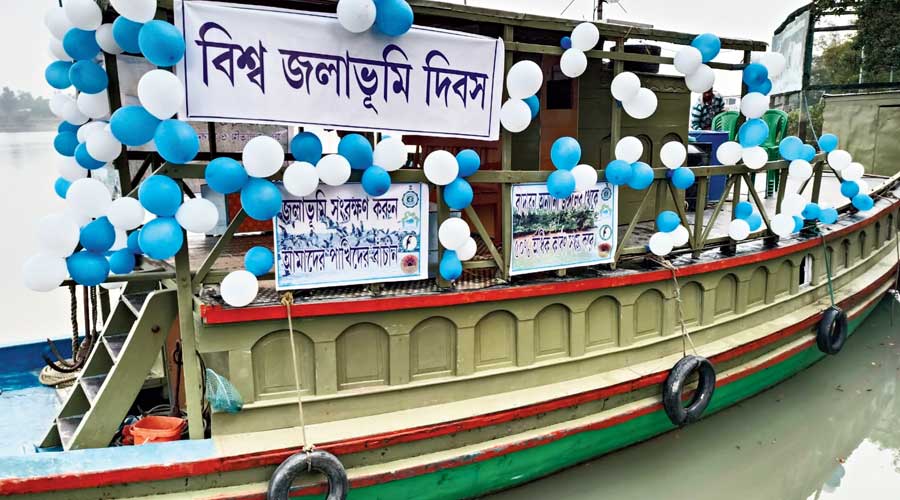Saviour from storms, home to a variety of flora and fauna, provider of livelihood and massive carbon sink.
Foresters and environment activists explained the many virtues of the mangrove wetlands to scores of teachers and students in the Sunderbans on Wednesday. February 2 is observed as World Wetlands Day.
A floating camp near the mudflats of Amla Methi, on the outskirts of Sajnekhali Wildlife Sanctuary, saw the participation of around 30 teachers from over a dozen government schools.
As a boat ferried the teachers past islands and along rivulets and creeks, the sighting of an open-billed stork or an egret got things going.
“Apart from being a repository of a diverse variety of flora and fauna, the wetlands of the Sunderbans protect the hinterland from storms, tidal surges and saltwater inundation. They also provide livelihood opportunities to thousands involved in fisheries. They are also a huge car¬bon sink. The wetlands should be protected for our own good,” an environment activist told the teachers.
On January 30 2019, the Indian Sunderbans were accorded the status of Wetland of International Importance under the Ramsar Convention.
The Sunderbans are spread across 10,000sqkm, a little above 4,000sqkm of which are in India.
“Sundarban Wetland is located within the largest mangrove forest in the world.... The Sundarbans are the only mangrove habitat which supports a significant population of tigers.... The Site is also home to a large number of rare and globally threatened species such as the criti¬cally endangered northern river terrapin (Batagur baska), the endangered Irrawaddy dolphin (Orcaella brevirostris), and the vulnerable fish¬ing cat (Prionailurus viverrinus)," says the Ramsar website.
“Two of the world’s four horseshoe crab species, and eight of India’s 12 species of kingfisher are also found here. The uniqueness of the habi¬tat and its biodiversity, and the many tangible and intangible, local, regional and global services they provide, makes the Site’s protection and management a conservation priority.”
Wednesday’s camp was organised by Sanctuary Nature Foundation, HT Parekh Foundation and Society for Heritage & Ecological Research (SHER), an NGO that works to mitigate humanwild conflict.
“Before the pandemic, such programmes used to be common at schools. But over the past two years, we have hardly had any formal chan¬nel of communication with children. Ahead of the reopening of schools, we wanted to sensitise teachers so that they would discuss these issues with the children,” said Joydip Kundu of SHER.
Chinmay Ray, a teacher at Rajat Jubilee High School, in the interiors of Gosaba, was one of the participants.
“Our students live in the lap of nature. They have an innate connection with nature, something that is nearly impossible for citybred children to feel. Instilling a sense of ownership of the natural resources in them is not very difficult,” he said.
The Sunderbans Tiger Reserve authorities also conducted four “floating” awareness camps with students to mark World Wetlands Day.
Around 20 pupils, from classes IX to XII, attended each programme. Members of the joint forest management committees collaborated with the foresters in organising the programmes.
“From saltwater crocodiles to lesser whistling ducks, the students spotted several inhabitants of this ecosystem,” said Soumen Mondal, assistant field director of the STR, who was on a boat off the Sudhanyakhali forest compartment near Sajnekhali.
